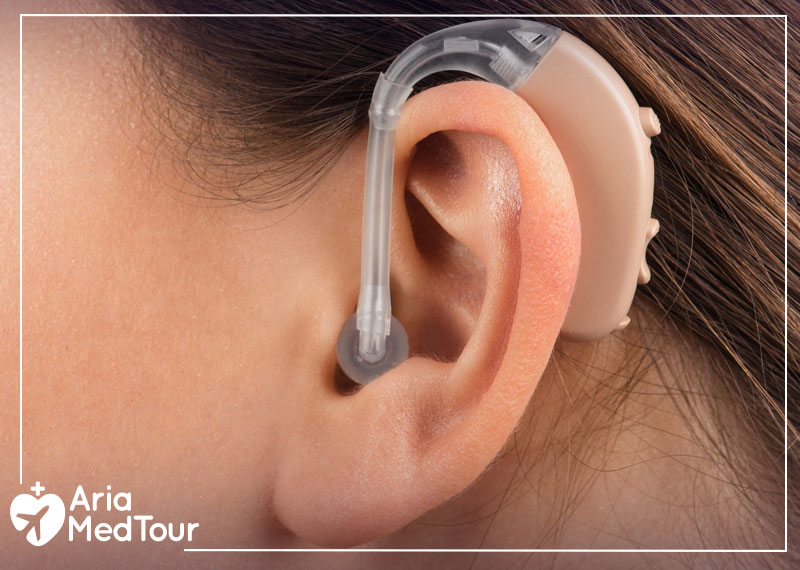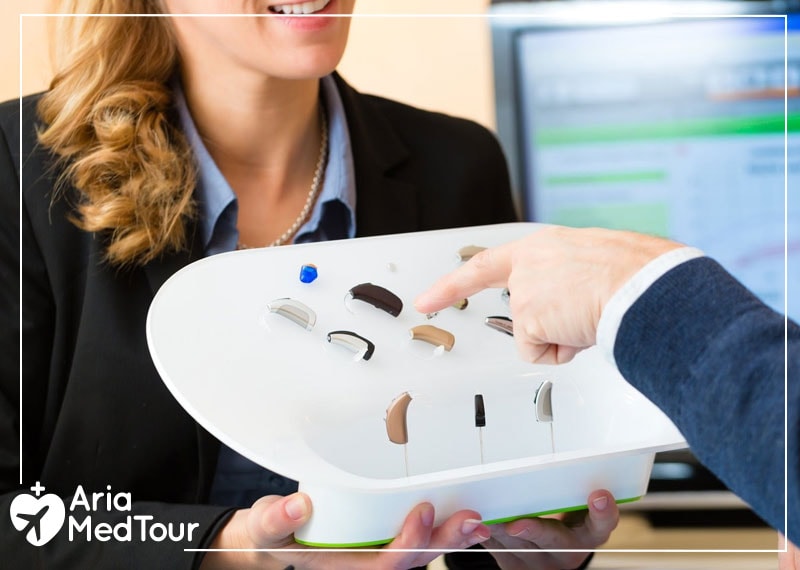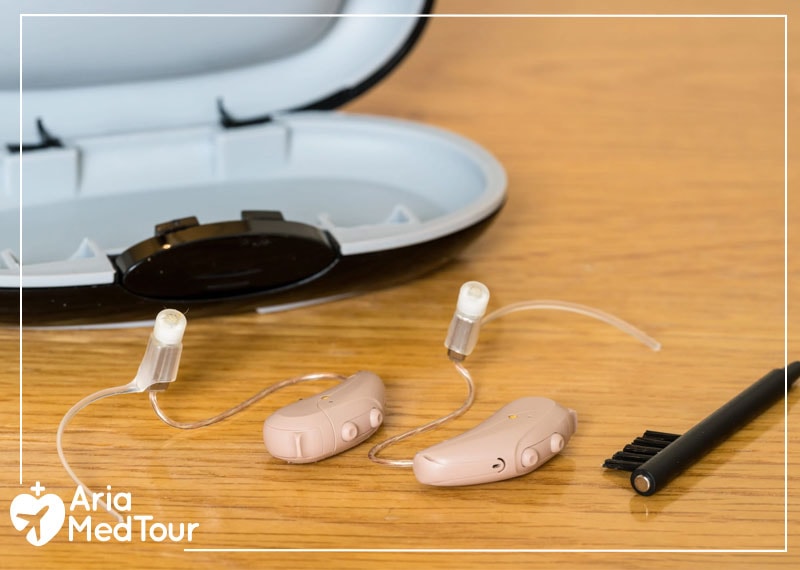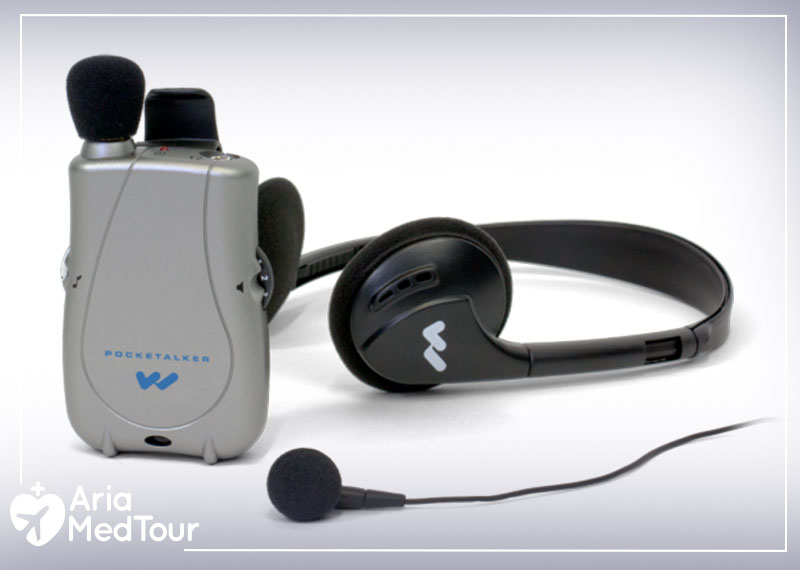Hearing Aids in Iran
Having hearing aids can enable you to hear better almost as when you were young.
Having hearing aids can enable you to hear better almost as when you were young.
One of the ways you can deal with hearing loss is using hearing aids, and you might have already thought about getting one yourself if you suffer from hearing loss. If so, you could be wondering about the types available and if they can help you. In this article, we will guide you to know more about hearing aids and the benefits of having hearing aids in Iran.
Hear about our patients’ experiences in Iran: They have so much to share.
Watch these stories from different patients around the world to see why people choose Iran for their cosmetic surgeries and how AriaMedTour facilitates their medical trip to Iran.
A medical trip documentary:
Crossing borders for a unique beauty adventure
Having Experienced a Failed Plastic Surgery,
Pakistani Girl Chooses Iran for a Perfect Revision
Beauty Redefined: A Cosmetic Surgery
Journey to Iran – AriaMedTour Documentary
A Smooth Medical Trip to Iran
for an Amazing Transformation
Swiss Patient Trusts Iran for
His Cosmetic Surgery Among All Destinations
Australian Lady Saves Money Having
Successful Plastic Surgeries in Iran
Croatian Girl’s Careful Research Led Her
to Iran for an Amazing Plastic Surgery
A Medical Trip to Iran Is Worth It as You Enjoy
Both Great Surgery Results and Low Prices
Why have hearing aids in Iran?
Iran is gaining more popularity as one of the best medical tourism destinations in the world. Iranian ENT (ear, nose and throat) doctors are among the best and they have a lot of experience and skill. The hospitals, clinics, and other medical facilities in Iran have advanced equipment.
By choosing to have hearing tests and buy hearing aids in Iran, you are guaranteed to have the best medical service at low cost. You will save money and have some satisfying results.
Why AriaMedTour?
Finding the best doctors can be really hard, and even harder when you are in a foreign country. AriaMedTour is the biggest medical tourism and healthcare service provider in Iran. When you ask for their services you can rest assured that you will find the best doctors and hospitals in Iran and make sure you get exactly what you are looking for.
The cost of hearing aids in Iran
In general, hearing aids cost ranges from $1,000 to $4,000. The cost depends on many factors such as the available features, brand, and the type of hearing aid. It might sound very expensive, but if you divide the price by the hearing aid’s lifespan then the cost will be only $0.5 to $2 a day.
Haven’t decided yet? Let us help you, it’s free
Since we rely on our hearing sense with a lot of our everyday tasks, hearing loss can have a great effect on the way we live. Hearing loss can affect every part of our life from our work to our emotional life.

A hearing aid is a device designed to improve hearing by making sound audible to a person with hearing loss.
Hearing aids are electronic devices that you wear to help you improve your hearing. A hearing aid consists of a microphone, an amplifier, a processor, and a speaker. They all work together to pick up the sounds and send them to your ears so you can hear better.

A hearing aid is a battery-powered electronic device designed to improve your hearing.
The first thing you need to keep in mind is that hearing aids can improve hearing and not restore it. If you are suffering from mild to moderate hearing loss or sensorineural hearing loss, then hearing aids can help you enhance your hearing.
Almost all of them works with the same principle. The microphone will detect the sound from your surroundings while a processor will convert the sounds into electrical signals and amplify them with the amplifier. The speaker will finally receive the signals and convert them back into sound.
How do hearing aids work?
There are three easy steps to follow in order to put on hearing aids:
If you are not sure whether you need a hearing aid or not, then you should start looking for the common signs of hearing loss. In general, if you experience any or some of the following situations, you might consider having a hearing aid:

How can I find out if I need a hearing aid?
Hearing aids are different from each-others. There are several types, shapes, sizes, and styles of hearing aids. You can find:
Of course, it is not limited to just 4 types of hearing aids as each one comes in several designs and types. Every one of the mentioned above hearing aids have their pros and cons, and you have to choose the right one for you based on your condition and preferences.
Behind the ear hearing aids consist of two parts; the device which is located behind the ear, and an extended part that goes inside the ear. There are 2 main types of behind the ear hearing aids:
It is also known as receiver in the canal (RIC) hearing aids. In this type, the receiver is located inside the ear whilst the rest of the device is behind the ear.
RITE hearing aids pros:
RITE hearing aids cons:
There are a lot of styles and types of behind the ear with earmold hearing aids. It is almost similar to RITE hearing aids. The difference is that the receiver is not in the ear.
Behind the ear hearing aid with earmold is one of the oldest types of hearing aids and has many advantages, such as:
There are some disadvantages as well:
This type of hearing aids is fixed in the outer ear with a small part within the canal. All of the parts of the in the ear (ITE) hearing aids are inside the ear. This hearing aid type is used to improve hearing for patients with mild to severe hearing loss.
ITE hearing aids advantages:
ITE hearing aids disadvantages:
Completely in the canal (CIC) hearing aids are small and meant to be hidden inside your ear canal. They are used to help patients who suffer from mild to moderate hearing loss.
CIC hearing aids pros:
CIC hearing aids cons:

Different types of hearing aids
When you are buying a hearing aid, you are not just buying a product but you are investing your time and money in a product. Hearing aids have a lifespan of 5 to 6 years with good care of course.
So, before you buy a hearing aid you should ask yourself a few questions to make sure you have made the right choice.
First, you need to know what follow-up care you would get after you get the hearing aid. Some hearing aids come with follow-up care and it can be necessary to reduce your maintenance cost in the future.
Warranties too are important, so you should pay attention to what things are covered in your warranty. Even with the advancement of the technologies of manufacturing hearing aids, it is reasonable to expect that you need to repair the hearing aid at some point.
Getting used to your hearing aids can be difficult for some patients. The feeling of the hearing aid in your ear and the changes in hearing can feel strange. To help yourself getting used to or adjust to your hearing aid you can:
Most of the patients who need hearing aids start asking: which hearing aid will work best for me? The answer is always different depending on the person asking. Choosing the hearing aid depends on the severity of the hearing loss, your lifestyle, and your preferences of course.
For example, if you have an active lifestyle, you need to choose a hearing aid that does not fall from your ear easily. You should also take hearing aid batteries, hearing aids brand and hearing aid insurance into your consideration. Keep in mind that you should consult your hearing aid specialist as he/she can help you make better decisions.

How should we choose the best hearing aid?
One of the important questions you need to ask when you buy a hearing aid is “how can I take care for my hearing aid?” Taking good care of the hearing aid is the key to prevent any damage. If you want to keep your hearing aid in the best shape, you should stick to the following:

How should we clean and take care of hearing aids?
Some of the advanced hearing aids now come with few extra features. The new features can help you have a better experience with the hearing aid. Some of the features include:
If you do not want to spend a lot of money on hearing aids but still want something to improve your hearing, there are some alternatives available. There are different alternatives to hearing aids, some of them is are smartphone apps and others are electronic devices.
Just keep in mind that these alternatives are not always approved by medical experts, so they might not be as reliable as hearing aids.

Alternative devices to hearing aids
As said before, the best hearing aid is selected based on many factors like the type of hearing loss and your lifestyle. Generally, you can follow these rules to decide on the best hearing aid for you:

The best hearing aid is selected based on many factors like the type of hearing loss and your lifestyle.
If you want to arrange your trip to Iran, you only need to contact AriaMedTour asking for our services. AriaMedTour will help you to obtain a visa to Iran. Upon your arrival, we will send an assistant to pick you up from the airport and take you (and your companions) to the hotel.
Next, we will choose the best hospital and clinics for you, appoint treatments by the best doctors in the country, and offer you pre-hospitalization and post-hospitalization services. You can also enjoy the online follow-up services even after you return home.
Are dental fillings metal?
No, some dental filling materials are metals, such as amalgam and gold, but other materials such as composite materials, glass ionomer, and ceramic are not metals.
Are dental fillings safe for MRI?
MRI will not affect dental fillings, to be loose or come out. However, tooth filling may cause a little distortion to the image within the neck and head area.
Can dental fillings be replaced?
For many reasons, including discoloration and crack of the filling, dental filling may fell out or cause hypersensitivity, irritation of the pulp or dental filling failure. In such cases, the damaged tooth filling can be replaced with a new one.
Can dental fillings cause mercury poisoning?
It is controversy matter. Mercury in amalgam dental filling has been accused for a long time to be a poisoning material, but there are no clear evidences that the mercury of tooth filling may cause poisoning.
However, it is recommended never to be used during pregnancy, in infants under the age of six years, and in some other high group risk people.
Does dental filling hurt?
Generally speaking, dental filling does not hurt and it is very safe. However, in some little cases, dental filling pain may be due to the nearness of the tooth filling to the tooth pulp, which may cause pulpitis, or due to sensitivity, over filling, allergic reaction. Furthermore, referred pain may occur. However, these symptoms are temporary, and dental filling pain relieving may need some procedures if pain persists.
Does dental filling need anesthesia?
The dentist usually use local anesthesia injection to lessen the pain and to dominate the fears of the patient, but removing the decay and dental filling without drilling may be done completely without anesthesia.
Does dental filling cause bad breath?
Dental filling by does not cause bad breath at all. But when it is cracked or damaged, it may offer a place for halitosis-causing bacteria to hide. Your dentist may examine your teeth and old fillings to detect any new problem and make a dental filling replacement.
Can I have dental filling when pregnant?
In the second and third stage of pregnancy, you can get a dental filling during pregnancy, but it is recommended in this case that the tooth filling not to be amalgam at all.
How does dental filling work?
By filling the prepared cavity with a dental filling, it prevents the cavity from attracting food debris and bacteria. This way, further decay and pain are prevented.
What dental fillings are made of?
There are many kinds of dental filling materials such as gold, porcelain, silver amalgam (silver, tin, zinc, and copper mixed with mercury) while a composite tooth filling is a mixture of powdered glass and plastic resin. Glass ionomer consists of a basic glass and acidic water-soluble powder.
How long should dental filling last?
A dental filling, especially amalgam and gold filling, may last for 10-15 years. The lifespan of tooth filling depends on several factors including the depth and horizontal extent of the cavity. Earlier treatment for a primary decay gives the patient an excellent result, while in advanced decay, the patient may need pulpitis and a crown.
Which dental filling is the safest one?
All dental fillings are safe, and the dentist and the patient choose the most appropriate option according to the situation. Composite resin and ceramic fillings are preferable in the anterior teeth, while amalgam and gold fillings are preferable in the posterior teeth and glass ionomer is preferable for filling at the gum line. Increasingly more research consider amalgam a more effective and long-lasting treatment for dental decay.
When to replace the dental filling?
Tooth-filling replacement can be done in cases of partial damage, dental filling discoloration for the anterior tooth filling, and/or the existence of decay under the old filling.
What is amalgam dental filling?
Amalgam is a compound of silver, tin and copper. These elements are amalgamated with mercury (liquid) to form an amalgam. The dentist fills the cavity with this compound during a few minutes. Although the compound contains mercury, but these elements are combined together to form a safe, FDA- approved cavity filling.
Will dental filling cure the cavity?
The dental filling does not cure the decay, but it stops the destruction of the tooth and prevents the debris of food from accumulating and hurting the tooth.
Contact Our Medical Support Team: